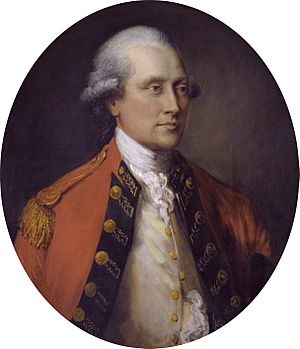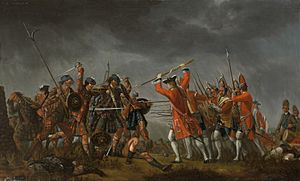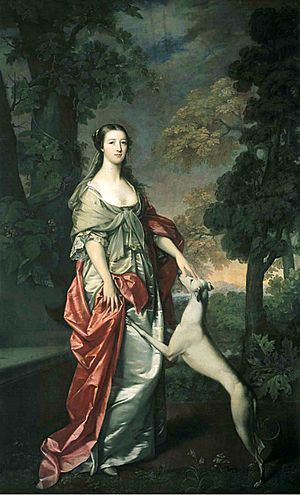John Campbell, 5th Duke of Argyll facts for kids
Quick facts for kids
The Duke of Argyll
|
|
|---|---|

5th Duke of Argyll
|
|
| Predecessor | John Campbell, 4th Duke of Argyll |
| Successor | George Campbell, 6th Duke of Argyll |
| Born | June 1723 |
| Died | 24 May 1806 (aged 82) |
| Buried | Argyll Mausoleum |
| Nationality | British |
| Wars and battles | Jacobite rising of 1745 |
| Spouse(s) | |
| Issue |
|
| Parents |
|
Field Marshal John Campbell, 5th Duke of Argyll (born June 1723 – died 24 May 1806) was an important Scottish soldier and nobleman. He was known as the Marquess of Lorne from 1761 to 1770. John Campbell served as a junior officer in Flanders during a big war. Later, he commanded a regiment in Scotland. He fought against the Jacobites in the Jacobite Rebellion. He was part of battles like Falkirk Muir and Culloden. After his military career, he became a Member of Parliament. He eventually retired to Inveraray Castle.
Contents
Early Life and Military Start
John Campbell was born in June 1723. His father was John Campbell, 4th Duke of Argyll. His mother was Mary Campbell (née Bellenden). She was the daughter of John Bellenden, 2nd Lord Bellenden. John Campbell went to a private school in London.
In 1739, he joined the army. He became a second lieutenant in the 21st Royal Scots Fusiliers. He quickly rose through the ranks. He was promoted to captain in 1741 and major in 1743.
Fighting in Europe and Scotland
In March 1744, John Campbell became a Member of Parliament. But he was soon sent to Flanders. There, he served in the War of the Austrian Succession. This was a major conflict in Europe.
In 1745, he became a lieutenant colonel. He commanded the 30th Regiment of Foot. He was sent back to Scotland. He faced the Jacobites at Loch Fyne in November 1745. This was early in the Jacobite Rebellion.
He fought in the Battle of Falkirk Muir in January 1746. The British cavalry faced a tough defeat there. He also served under the Duke of Cumberland. This was at the Battle of Culloden in April 1746. The Jacobites were finally defeated in this battle.
Rising Through the Ranks
In 1749, Campbell took command of the 42nd Regiment of Foot. This regiment was serving in Ireland. He became the adjutant-general in Ireland in 1754. This was a very important military role.
He continued to receive promotions. He became a colonel in 1755. He commanded the 54th Regiment of Foot. Later, he commanded the 14th Dragoons. In 1759, he was promoted to major-general. By 1761, he was a lieutenant general.
When his father became the 4th Duke of Argyll, John took the title Marquess of Lorne. He left the House of Commons. But he was elected again in 1765 for Dover, an English seat. He became colonel of the 1st Regiment of Foot that same year.
Later Life and Achievements
In November 1766, John Campbell was made Baron Sundridge. This meant he became a peer. He left the House of Commons again. In 1767, he was appointed Commander-in-Chief, Scotland. This was a very high military position.
In November 1770, he became the 5th Duke of Argyll. He inherited this title from his father. He was promoted to full general in 1778. He also became colonel of the 3rd Regiment of Footguards in 1782. In 1794, he was appointed Lord Lieutenant of Argyllshire. This was a civil role in his home county.
His final military promotion was to field marshal in 1796. This is the highest rank in the British Army.
After his military career, he lived at Inveraray Castle. He became very interested in improving farming. He was part of the Board of Agriculture. He was also the first president of the Highland and Agricultural Society. He passed away on May 24, 1806. He was buried at Kilmun Parish Church.
Family Life
In 1759, John Campbell married Elizabeth Gunning. She was already a widow. She had two sons from her first marriage. Elizabeth was later given her own title, Baroness Hamilton of Hameldon.
John and Elizabeth had five children together:
- Lady Augusta Campbell (born 1760, died 1831)
- George John Campbell, Earl of Campbell (born 1763, died 1764)
- George William Campbell, 6th Duke of Argyll (born 1768, died 1839)
- Lady Charlotte Susan Maria Campbell (born 1775, died 1861)
- John Douglas Edward Henry Campbell, 7th Duke of Argyll (born 1777, died 1847)
Images for kids
| Parliament of Great Britain (1707–1800) | ||
|---|---|---|
| Preceded by Neil Buchanan |
Member of Parliament for Glasgow Burghs 1744–1761 |
Succeeded by Lord Frederick Campbell |
| Preceded by Sir Joseph Yorke |
Member of Parliament for Dover 1765–1766 |
Succeeded by Sir Joseph Yorke |
| Military offices | ||
| New regiment | Colonel of the 54th Regiment of Foot 1755–1757 |
Succeeded by John Grey |
| Preceded by Louis Dejean |
Colonel of the 14th Regiment of Dragoons 1757–1765 |
Succeeded by Charles FitzRoy |
| Preceded by Sir Henry Erskine |
Colonel of the 1st (Royal) Regiment of Foot 1765–1782 |
Succeeded by Lord Adam Gordon |
| Preceded by The Earl of Loudoun |
Colonel of the 3rd Regiment of Foot Guards 1782–1806 |
Succeeded by The Duke of Gloucester |
| Honorary titles | ||
| New office | Lord Lieutenant of Argyllshire 1794–1799 |
Succeeded by Marquess of Lorne |
| Peerage of Scotland | ||
| Preceded by John Campbell |
Duke of Argyll 1770–1806 |
Succeeded by George Campbell |
| Peerage of Great Britain | ||
| New creation | Baron Sundridge 1766–1806 |
Succeeded by George Campbell |





